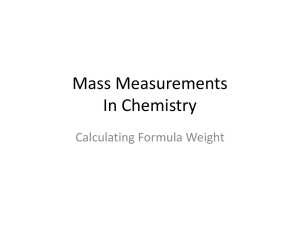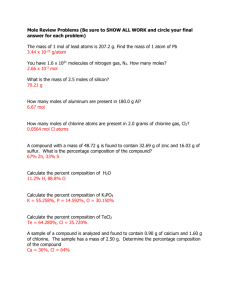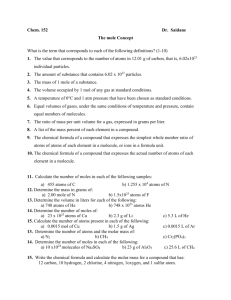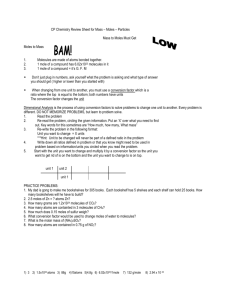Chemistry
advertisement
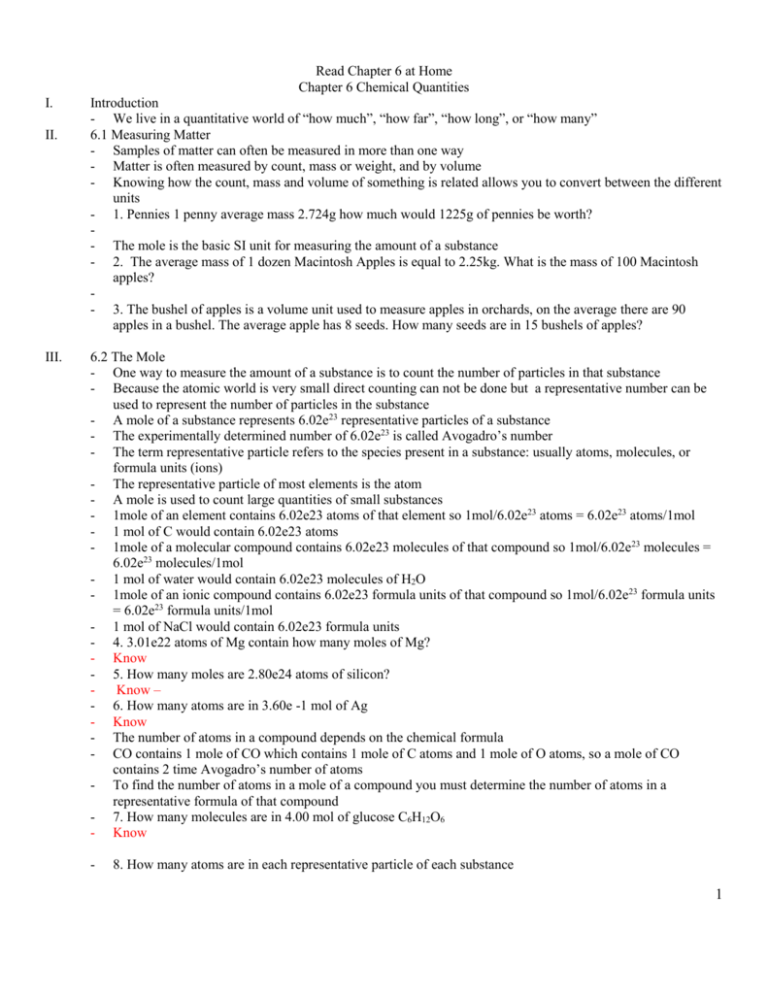
Read Chapter 6 at Home Chapter 6 Chemical Quantities I. II. III. Introduction - We live in a quantitative world of “how much”, “how far”, “how long”, or “how many” 6.1 Measuring Matter - Samples of matter can often be measured in more than one way - Matter is often measured by count, mass or weight, and by volume - Knowing how the count, mass and volume of something is related allows you to convert between the different units - 1. Pennies 1 penny average mass 2.724g how much would 1225g of pennies be worth? - The mole is the basic SI unit for measuring the amount of a substance - 2. The average mass of 1 dozen Macintosh Apples is equal to 2.25kg. What is the mass of 100 Macintosh apples? - 3. The bushel of apples is a volume unit used to measure apples in orchards, on the average there are 90 apples in a bushel. The average apple has 8 seeds. How many seeds are in 15 bushels of apples? 6.2 The Mole - One way to measure the amount of a substance is to count the number of particles in that substance - Because the atomic world is very small direct counting can not be done but a representative number can be used to represent the number of particles in the substance - A mole of a substance represents 6.02e23 representative particles of a substance - The experimentally determined number of 6.02e23 is called Avogadro’s number - The term representative particle refers to the species present in a substance: usually atoms, molecules, or formula units (ions) - The representative particle of most elements is the atom - A mole is used to count large quantities of small substances - 1mole of an element contains 6.02e23 atoms of that element so 1mol/6.02e23 atoms = 6.02e23 atoms/1mol - 1 mol of C would contain 6.02e23 atoms - 1mole of a molecular compound contains 6.02e23 molecules of that compound so 1mol/6.02e23 molecules = 6.02e23 molecules/1mol - 1 mol of water would contain 6.02e23 molecules of H2O - 1mole of an ionic compound contains 6.02e23 formula units of that compound so 1mol/6.02e23 formula units = 6.02e23 formula units/1mol - 1 mol of NaCl would contain 6.02e23 formula units - 4. 3.01e22 atoms of Mg contain how many moles of Mg? - Know - 5. How many moles are 2.80e24 atoms of silicon? Know – - 6. How many atoms are in 3.60e -1 mol of Ag - Know - The number of atoms in a compound depends on the chemical formula - CO contains 1 mole of CO which contains 1 mole of C atoms and 1 mole of O atoms, so a mole of CO contains 2 time Avogadro’s number of atoms - To find the number of atoms in a mole of a compound you must determine the number of atoms in a representative formula of that compound - 7. How many molecules are in 4.00 mol of glucose C6H12O6 - Know - 8. How many atoms are in each representative particle of each substance 1 IV. - V. - Ammonium Nitrate (Used in fertilizer) - Acetylsalicylic acid (aspirin) C9H8O4 - Ozone O3 - Nitroglycerin (explosive) C3H5(NO3)3 - 9. How many molecules are in 2.14 mol CO, how many total atoms would be in the CO? - Know – 6.3 The Gram Formula Mass - The gram atomic mass (gam) is the atomic mass of an element expressed in grams - Look your periodic table for these gam C=12.0g S=32.1g N=14.0g - The gram atomic mass of any two elements must contain the same number of atoms - 12.0g of C compared to 14.0g of N both contain 6.02e23 atoms in one mole - The mole is defined as the amount of substance that contains as many representative particles as the number of atoms in 12.0g of C-12 - 1 mole of C = 12.0g or 1gam C 1 mole of N = 14.0g or 1gam N - The gram atomic mass is the mass of one mole of atoms of any element - 1 mole of Al = 27.0g or 1gam Al, it would contain 6.02e23 atoms of Al - 10. List mass per mole for each of the following (3 sf) - Na Se Pb K - 2 - The gram molecular mass (gmm) of any molecular compound is the mass of one mole of that compound - 11. What is the gram molecular mass of Hydrogen Peroxide (dihydrogen dioxide) - H2O2 Dicarbon Hexahydride g Phosphorus trichloride g C3H7OH g Dinitrogen Pentoxide g - The mass of 1 mol of an ionic compound is the gram formula mass (gfm) - The gfm is calculated the same way as the gmm – simply sum the atomic masses of the atoms (ions) that are in the formula of the compound - 12. What is the gram formula mass of ammonium carbonate - g - Strontium Cyanide - g - Sodium Hydrogen Carbonate g - Aluminum Sulfite - g 13. Find the mass of 2.25 moles of calcium g 14. Find the mass of 3.56 moles of FeO g Do 6-3 problems – 2 steps 1st find mass of 1 mole then of number of moles 6.4 The molar Mass of a Substance - gam (atoms), gmm (molecules), and gfm (formula units) are all used to represent a mole of a particular kind of substance - gfm can be used to refer to a mole of any substance 2 - VI. The term molar mass is often used in place of gfm to refer to a mass of a mole of any element or compound Gmm must be used when you are talking about a diatomic molecule such as H2, F2, Cl2, Br2, I2, N2, O2 - GAM – single atom H, F, Cl, Br, I, N, O - Do 6-4 problems 6.5 Mole – Mass Conversions - The gfm of an element or compound is used to convert grams of a substance into moles - Grams A = 1mole A/gfm A = # moles of A - The gfm can also be used to convert moles of a substance into grams - Mol B x gfm/1mol B = grams B - 15. How many grams are in 7.20 mol of Dinitrogen trioxide? - g - 7.25 mol Be g - 2.40 mol N2 1 1.12 mol K2CO3 - 1 16. Find the number of moles in 92.2 g of Iron (III) Oxide F 5.00g of H2 2 VII. 72.0g Ba 1 333 g SnF2 1 How many atoms are in 333g of SnF2 - 1mol = 6.02e23atoms 3 Do problems 6-5 – as Practice Quiz 6-2 thru 6-5 6.6 The Volume of a Mole of Gas (Glove and beaker water in the Bell Jar) - The volume of a gas changes with changes in temperature and pressure - Because of this a volume of gas is usually measured at standard temperature and pressure (STP) - STP is 0 C and 101.3 kPa or 1 atmosphere - The Earth is surrounded by a blanket of air, which we call the atmosphere. It reaches over from the surface of the Earth to around 560 km or 348 miles - 75% of the air in our atmosphere is in the first layer called the troposphere which extends from the surface to 8 to 14 km (about 5 to 9 miles) upward - At STP all gases occupy 22.4L, this quantity is known as the molar volume of a gas and is measured at STP - Since a mole of any substance contains 6.02e23 particles of that substance – 22.4 L of gas at STP contains 6.02e23 particles of that gas - The masses of 1 mole of different gases will differ at STP - 17. How many liters of SO2 gas at STP would you have if you had 6.00e-1 mol of SO2 - A - Determine the number of moles in 33.6L of He gas at STP - 3 - Determine volumes of these gases at STP - 3.20e -3 mol CO2 3.70 mol N2 - How many moles are in these volumes of gases at STP - 67.2L of SO2 - 8.80e -1 L of He 3 VIII. IX. X. 6.7 Gas Density and the Gram Molecular Mass - The density of a gas is usually measured in g/L - The experimentally determined density of a gas at STP is used to calculate the gram formula mass of that gas - Density = mass/volume - Density = molar mass/molar volume - For gases density = molar mass/22.4L - Molar masses can be used to identify Gases at STP - You have 3 containers with gases in each container - In container A the density is 1.25g/L in container B the density is 2.86g/L and in container C the density is 7.14e -1 g/L - Identify each gas as NH3 SO2 Cl2 N2 or CH4 6.8 Convert among measurements of mass, volume, and number of particles, using the mole - To change from one unit to another the mole is used as an intermediate step - The form of the conversion factor depends on whether you are going from moles or to moles - The weight of a diamond is given in carats. One carat is equal to 1/142 of an ounce. - Girls a boy shows up at your house and offers you a 3.00 carat carbon ring! - Throw him out! - He returns with a 3.00 carat Blue Nile diamond ring! - Marry Him – worth about $180 000 - The 3.00 carat ring would be .600 g of pure carbon - How many moles of carbon would be in the diamond - How many atoms of carbon do you have? What is the mass in grams of 1 atom of Hg? 6.9 Calculate the percent composition of a substance from its chemical formula or experimental data - The relative amounts of elements in compounds is expressed as the percent composition - Percent composition shows the percent by mass of each element in the compound - % mass of element A = g of A/g of compound x 100 - Example Problems (Finding % comp when masses of reactants are given) - An 8.20g piece of Mg combines completely with 5.40g of oxygen to form a compound. What is the compound and what is its percent composition? - Know: - Find % comp of the following: - 9.03g of Mg combines completely with 3.48g N Know: - 29.0g of Ag combines completely with 4.30g of S - Know: - To calculate the percent composition when the given is the compound and not the mass of the elements that make up the compound - %comp = g of element in 1 mol of compound/gfm of compound x 100 - Simple steps of calculating percent composition - 1. Add the masses of each element in the compound to find total mass - 2. Divide the mass of one element by the total mass (GFM) multiply by 100 - 3. Repeat step 2 for each element in the compound - 4. Add up all the percentages to make sure they equal 100% - Calculate the percent composition of Propane C3H8 - Know: - Calculate the percent comp of the following: - Calcium Acetate - Hydrogen Cyanide - Using percent composition to find the amount of an element used in making a compound - Find the percent composition – multiply percent over one hundred by the amount of the compound - Calculate the mass of carbon in 82.0g of propane, C3H8 4 XI. X. - How many grams of each element would be found in 105g of H2O - 6.9 Calculating % comp 6.10 Calculating Empirical Formulas - The empirical formula gives the lowest whole number ratio of the atoms of the elements in a compound - It indicates the kinds and relative counts (atoms or moles of atoms) in molecules or formula units of a compound - Microscopic interpretation in terms of atoms CO2 – 1 C and 2 O - Macroscopic interpretation in terms of moles - CO2 – 1 mol of C (6.02e23 carbon atoms) and - 2 moles of O or 2 x (6.02e23 oxygen atoms) or 1.20e24 oxygen atoms - An empirical formula may or may not be the same as the molecular formula - If they are different the molecular formula is a simple multiple of the empirical formula - CO2 – empirical and molecular formula same - Dinitrogen tetrahydride molecular formula N2H4 its empirical formula would be NH2 because it is the simplest ratio of N to H in the compound - Determining if it is a empirical formula Page 167 example 15 - Steps to calculate empirical formulas from percent composition 1. Find the % composition of each element in the compound 2. Assume that 100g of sample of compound so % = mass 3. Multiply mass of each element by 1mol/gfm = moles of each 4. Divide all the moles by the smallest – if all numbers come out be whole numbers use the numbers for the subscripts in empirical formula 5. If the numbers are not whole numbers but are close round to whole numbers (1.95 would be 2 – 1.10 would be 1) 6. if numbers end in .25 x 4, .33 x 3, .5 x 2, .67 x3, .75 x 4, .8 x 5 to get whole numbers – all numbers must be multiplied by same number - Page 168 concept practice 33 practice problem 34 and 35 6.11 Calculating Molecular Formulas - You can determine the molecular formula of a compound if you know its empirical formula and its gram formula mass - Steps of calculating Molecular formula - 1. Calculate the empirical formula mass (efm) by adding up all the gram atomic masses (gam) of the elements present in the empirical formula - 2. Divide (efm) into the gram formula mass (gfm) – it takes this many of the empirical formula units to make up the molecular formula of the compound - The compound methyl butanoate smells like apples. Its percent composition is 58.8% C, 9.8% H, and 31.4% O. If its gram molecular mass is 102 g/mol, what is its molecular formula? Work in notes 5


